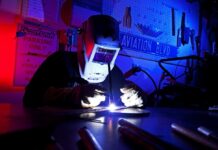 It would be impressive for one to attend AirVenture and go home without a record number of steps tracked in their smart phone health app or fitness watch. Exercise is a wonderful side effect of each day spent here at the show, and it can be both physical and mental. At the Lycoming engine assembly workshop (held daily at the Lycoming engines booth) you will be reminded of the importance of keeping your mind in shape for reading and accurately comprehending technical documents.
It would be impressive for one to attend AirVenture and go home without a record number of steps tracked in their smart phone health app or fitness watch. Exercise is a wonderful side effect of each day spent here at the show, and it can be both physical and mental. At the Lycoming engine assembly workshop (held daily at the Lycoming engines booth) you will be reminded of the importance of keeping your mind in shape for reading and accurately comprehending technical documents.
Expertly presented by Mike Damiani, instructor of Aviation Maintenance at the Pennsylvania College of Technology, and assisted by second year student Connor Flynn, the first 15 minutes of the workshop examined the Lycoming Service Instruction for engine assembly lubrication guidelines. Yet more time was dedicated to decoding torque values and bolt torquing procedures.
Like a personal trainer working the aerospace muscle group of your brain, Damiani, reminded attendees that scrutiny and focus are skills built by repetition and discipline.
 Does that mean reading technical documents is fun? Absolutely not, empathized Damiani, “This publication is not a well written publication, you have to read it… ten times.” Not fun and necessary often overlap so tightly you can barely discern they are two different elements of the Venn diagram. Practice makes perfect, and practice will slowly pull the necessary category tasks into the fun category when pursuing complicated endeavors.
Does that mean reading technical documents is fun? Absolutely not, empathized Damiani, “This publication is not a well written publication, you have to read it… ten times.” Not fun and necessary often overlap so tightly you can barely discern they are two different elements of the Venn diagram. Practice makes perfect, and practice will slowly pull the necessary category tasks into the fun category when pursuing complicated endeavors.
Many have noticed while reading Service Instructions that specific types of sealants and lubricants are no longer in existence, or due to supply chain issues have become unobtainable. Sometimes more technically-advanced or user-friendly products become available, but are not listed in the Service Instructions. You may need to search for three different specifications of a lubricant in your internet browser before you find one available to purchase. 
Like building an airplane, the experience of building up and engine is infrequently about bolting large things together for a moment of satisfaction. Rather it is one of laying a foundation of discipline and time invested, which will pay dividends in the creation of a safe machine.
Despite what some might presume to be a tedious two hours, the presentation was engaging and illuminating, and attendance was strong. If nothing else, those of us who are not (yet) A&Ps or engine assembly experts learned a lot about the powerplant hearts of our flying machines, and the creative use of rubber bands in place of a third hand.













